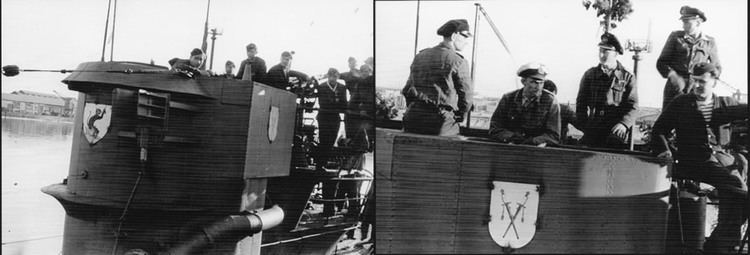Name U-953 Yard number 153 Commissioned 17 December 1942 Launched 28 October 1942 Draft 4.74 m Builder Blohm + Voss | Ordered 10 April 1941 Laid down 10 February 1942 Construction started 10 February 1942 Length 67 m Beam 6.18 m | |
 | ||
Fate Transferred to England, 29 May 1945Broken up, 1950 Part of 5th U-boat Flotilla, 33rd U-boat Flotilla | ||
U-953 was a Type VIIC U-boat of Nazi Germany's navy (Kriegsmarine) during World War II.
Contents
The submarine was laid down on 10 February 1942 in the Blohm & Voss yard at Hamburg, launched on 28 October 1942, and commissioned on 17 December 1942 under the command of Oberleutnant zur See Karl-Heinz Marbach.
After training with the 5th U-boat Flotilla at Kiel, U-953 was transferred to the 3rd U-boat Flotilla based at La Pallice (in southwestern France), for front-line service on 1 June 1943. She sailed on ten war patrols, but sank only one ship of 1,927 gross register tons (GRT). She was transferred to the 33rd U-boat Flotilla on 15 October 1944, under the command of her second skipper, Oblt.z.S. Herbert Werner, author of the memoir Iron Coffins. U-953 was surrendered at Trondheim in Norway on 9 May 1945.
Design
German Type VIIC submarines were preceded by the shorter Type VIIB submarines. U-953 had a displacement of 769 tonnes (757 long tons) when at the surface and 871 tonnes (857 long tons) while submerged. She had a total length of 67.10 m (220 ft 2 in), a pressure hull length of 50.50 m (165 ft 8 in), a beam of 6.20 m (20 ft 4 in), a height of 9.60 m (31 ft 6 in), and a draught of 4.74 m (15 ft 7 in). The submarine was powered by two Germaniawerft F46 four-stroke, six-cylinder supercharged diesel engines producing a total of 2,800 to 3,200 metric horsepower (2,060 to 2,350 kW; 2,760 to 3,160 shp) for use while surfaced, two Brown, Boveri & Cie GG UB 720/8 double-acting electric motors producing a total of 750 metric horsepower (550 kW; 740 shp) for use while submerged. She had two shafts and two 1.23 m (4 ft) propellers. The boat was capable of operating at depths of up to 230 metres (750 ft).
The submarine had a maximum surface speed of 17.7 knots (32.8 km/h; 20.4 mph) and a maximum submerged speed of 7.6 knots (14.1 km/h; 8.7 mph). When submerged, the boat could operate for 80 nautical miles (150 km; 92 mi) at 4 knots (7.4 km/h; 4.6 mph); when surfaced, she could travel 8,500 nautical miles (15,700 km; 9,800 mi) at 10 knots (19 km/h; 12 mph). U-953 was fitted with five 53.3 cm (21 in) torpedo tubes (four fitted at the bow and one at the stern), fourteen torpedoes, one 8.8 cm (3.46 in) SK C/35 naval gun, 220 rounds, and an anti-aircraft gun. The boat had a complement of between forty-four and sixty.
1st patrol
U-953 first sailed from Kiel on 13 May 1943, and out into the mid-Atlantic. She had no successes, and on 9 July was attacked by an aircraft, which killed one crewman and wounded two others. The U-boat arrived at La Pallice on 22 July after 71 days on patrol.
2nd and 3rd patrols
U-953's second Atlantic patrol from 2 October to 17 November 1943 was uneventful, but her next, which began on 26 December 1943 and took her to the waters off North Africa, was. On 11 January 1944 the U-boat fired a T-5 homing torpedo at a corvette, missed, and was then hunted for the next 13 hours by escort ships equipped with depth charges and hedgehogs. About 4 February the U-boat approached Convoy ON 222, but was attacked by an unknown Allied aircraft.
4th-6th patrols
After being fitted with a Schnorchel underwater-breathing apparatus, the U-boat's next three patrols from March to June 1944 were short, from 3 to 13 days and uneventful.
7th patrol
U-953 sailed on 24 June 1944 from Brest into the English Channel. It was previously reported that U-953 sank the British freighter Glendinning, on 5 July 1944, but this is now accredited to U-763.
8th-10th patrols
Under her new commander, Oblt.z.S. Herbert Werner, U-953 sailed from Brest on 12 August 1944, arriving at La Pallice on 19 August.
On 31 August U-953 left La Pallice for Norway, sailing round the Atlantic coast of Ireland. She patrolled the entrance to North Channel for seven days, but has no success. Werner reports a fault on the schnorkel caused the patrol to be abandoned and U-953 arrived at Bergen “unannounced” on 11 October.
Faults and a need for overhaul caused her to be sent to Germany, arriving at Flensburg on 25 October. She was not ready for further service until February 1945.
U-953 left Kiel on 4 February 1945, arriving at Kristiansand and then Bergen. On 21 February she left Bergen on an offensive patrol off the coast of Britain but, Werner reports, various faults culminating in a faulty torpedo tube door, forced a return once more. U-953 arrived back in Bergen on 3 April 1945.
Under a new commander, Oblt.z.S. E. Steinbrink, she was moved from there to Trondheim on 6 April arriving three days later; there she remained until the German capitulation and she was surrendered to British forces.
Wolfpacks
U-953 took part in six wolfpacks, namely.
Fate
On 29 May 1945 U-953 sailed to Loch Ryan as a British war prize in August. After trails by the Royal Navy, the U-boat was laid up in Lisahally at the end of the year. On 4 June 1949, U-953 was sold to Clayton & Davie Ltd. of Dunston and broken up for scrap.
